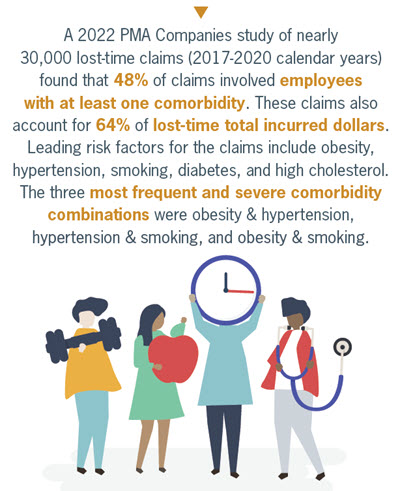
Taking your Risk Control Program to the next level by incorporating wellness into your employee safety initiatives can make a big difference in your workers' compensation results.
Safety professionals are beginning to take notice that employee health should not rest solely with human resources departments, but should also be part of your risk control strategy. This is because multiple studies show that comorbidities—preexisting health conditions that can hinder an injured worker’s recovery—are influencing workers’ compensation claims costs.
Six areas contribute to workers’ compensation frequency and severity trends. Five of them fit into the typical structure of risk control/employee safety: (1) physical hazards, (2) policies and procedures, (3) management, (4) financial resources, and (5) organizational culture. The sixth area—extremely important but often overlooked—is employee health.
How Two Risk Factors Contribute to Workers' Compensation Claims
Obesity is the most common chronic disease. Many factors can contribute to weight gain and obesity, including activity level, diet and eating patterns, sleep, genetics, and medications. Since obesity can contribute to many medical conditions, ranging from high blood pressure and type 2 diabetes to stroke and osteoarthritis, along with body pain and difficulty with physical functioning, you are likely to see the impact on health care claims costs. However, these conditions also affect workers’ compensation costs. The same is true for another risk factor, smoking, which can contribute to high blood pressure, anxiety and irritability, poor vision, lung conditions, and some cancers.
Consider these examples of how obesity and smoking can impact employee safety in the workplace:
- Obese individuals are at a higher risk for carpal tunnel syndrome, rotator cuff tendinitis, and lower back pain. They may also experience more severe injuries because extra weight generates
increased force during an accident such as a slip or fall.
- Sleep apnea triggered by obesity or high blood pressure, or even poor sleep tied to snoring caused by smoking, may lead to driver fatigue and auto accidents.
- Heat stress may impact an obese worker to a greater degree than a healthy weight person.
- Vision problems caused by smoking and/or uncontrolled high blood pressure may impact a worker’s ability to see safety warnings or unsafe conditions.
Integrating Employee Wellness into Your Risk Control Program
After researching and examining the value of incorporating employee wellness into your risk control program, you may want to consider the following approaches to support behavioral change:
1. Providing information and education to increase employee knowledge about obesity risks. Include an overview of how obesity can impact work and their risk of injury. Follow this with education and learning opportunities about a healthy diet, physical activity, healthy sleep, stress management, etc. This can take the form of lectures, written material (electronic or print), or educational software.
2. Addressing safety hazards that can be controlled by the organization before asking employees to make a lifestyle change. Otherwise, your efforts may come across as insincere and be viewed as a “money saver” for the company – rather than concern and support for the employee’s quality of life and
well-being.
3. Incorporating behavioral and social strategies to support positive beliefs, such as counseling, skill-building, and rewards, or reinforcement through support systems or health risk assessments followed by counseling.
4. Taking environmental approaches that make healthy choices easier and target the entire workforce by changing the physical environment or organizational structure. This may include improving access to healthy foods and providing more opportunities to be physically active at work.
5. Updating policies can help support behavioral change. Some examples include providing health insurance benefits or cash incentives for health club memberships. Additionally, allowing flexible work schedules might help to remove the barrier of time constraints to participating in physical activity.
We believe incorporating both risk control/safety areas with steps to improve employee health and well-being creates a more effective risk control approach. When your employees experience the benefits
of their company’s safety and wellness programs, they are far more likely to be loyal and work harder toward success. The added benefit is fewer injuries and illnesses that impact your workers’
compensation performance.
PMA Risk Control's employee wellness model provides an essential layer of prevention not found in traditional service approaches.
To learn more about incorporating your wellness strategy into your risk control program, reach out to your PMA Risk Control Consultant or contact us at heretohelp@pmagroup.com.
IMPORTANT NOTICE
The information and suggestions presented by PMA Companies in this risk control technical bulletin are for your consideration in your loss prevention efforts. They are not intended to be complete or definitive in identifying all hazards associated with your business, preventing workplace accidents, or complying with any safety related or other laws or regulations. You are encouraged to alter the information and suggestions to fit the specific hazards of your business and to have your legal counsel review all of your plans and company policies. PMA Companies and Old Republic Companies do not provide legal advice and the information and suggestions in this bulletin should not be considered as such.



